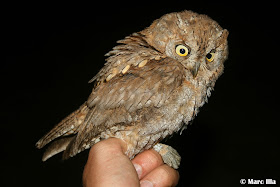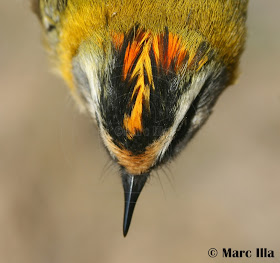Time is flying, and I still don't have time enough to post all the stuff I would like to!!

















Leaving many things hidden in my computer, this post will be about last week, birding around my place in central Catalunya.
Very little few transaharan migrants are still around Catalunya, mostly Swallows, Common Redstarts (Phoenicurus phoenicurus) and Reed Warblers (Acrocephalus scirpaceus). On the other hand, these dates are especially good for presarahan migrants: Blackcaps (Sylvia atricapilla), Robins (Erithacus rubecula), Song Thrushes (Turdus philomelos) and Chiffchaffs (Phylloscopus collybita).
Now it is also the best time here for migrating Firecrests (Regulus ignicapilla). Sexing is like in Goldcrests (Regulus regulus), but females usually have pale orangish crown, not completely yellow as in female Goldcrests.
 |
| Female. Crown feathers are orangish but not brightly coloured. |
 |
| Male. Even without showing all crown feather, orange is very bright. |
It seems it is going to be a good year for both European Siskins (Spinus spinus) and Hawfinches (Coccothraustes coccothraustes), both species that have different abundances depending on the winter. I have personally seen them usually during last weeks, and I even had the chance to catch this very nice adult male Siskin.



Last days have been also especially good for Stonechats (Saxicola rubicola) around my area.

 |
| First-year (EURING 3) male. All GCs and tertials moulted. |

 |
| First year (EURING 3) female. All GCs and tertials moulted. |

 |
| First-year (EURING 3) female. All GCs and two tertials moulted. |

 |
| First-year (EURING 3) female; with 3 outer greater coverts retained. |

 |
| Adult (EURING 4) female. |
Meadow Pipits (Anthus pratensis) and Water Pipits (Anthus spinioletta) are also appearing on migration and, some of them, reaching the wintering grounds. From the latter species I trapped two individuals last week, and one of them turned out to be a retrap from February!

 |
| Adult (EURING 4) |
The same river place provided also a first-year Grey Wagtail (Motacilla cinerea) and 5 Kingfishers (Alcedo atthis).


I had also some very unexpected birds!
One Scops Owl (Otus scops) was still around last week, being the latest record in my area so far. It was a first-year (EURING 3), with fat score 5!

 |
| Pale coloured flight feathers, with faint pattern and pointed tips are typical of first-year birds, Below, tail show very diffuse barring, almost lacking the black bars. In spring, birds can be age on the same characters, but with more wear on the feathers. |
The last Rock Bunting (Emberiza cia) I saw in my local patch was 5 years ago. Last Saturday, this first-year (EURING 3) female was unexpectedly caught for ringing!, being the first ringed in my place.

 |
| As many Emberiza species, all GCs where moulted. Moult limit is especially easy to see in this second picture, being both carpal covert and the smallest alula feather moulted. |

 |
| Faint dark marks and cold tones overall make this bird a female. |

Also, the first ever ringed Lesser Spotted Woodpecker (Dendrocopos minor) came on Sunday.


 |
| Sex is quite easy, being this bird a male on the reddish feathers in the forehead. Ageing is a bit more difficult. This bird is a first-year (EURING 3), with new primaries, lesser, median and most of the greater coverts and small alula feather moulted. Pattern of unmoulted secondaries, tertials and primary coverts are the most striking features on ageing this bird. |
 |
| Also, the central pair of tail feathers were moulted. See differences in wear, but also texture (quality) between the two generations. |





















